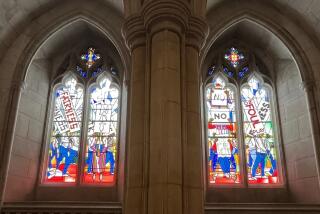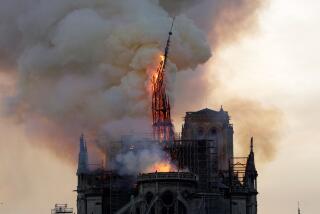The Stained-Glass Glory of Chartres
CHARTRES, France — A white-haired Frenchman wearing a tweed jacket, carrying his fedora in one hand and wielding a cane stylishly with the other, introduced Chartres Cathedral to me 25 years ago.
He talked in British English of his experiences in World War I and II and gave genial advice on how to savor the cathedral.
I have returned to Chartres--50 miles southwest of Paris--many times.
My recent guides to the cathedral have been different--young British scholars who are in residence for a year to study the sculpture and stained glass, give tours and present polished historical essays.
The scholars are impressive, but the old Frenchman knew how to perform an introduction. He led us past windows that seemed from the outside a nondescript tan into the cathedral through the front door (the west portal).
Then very slowly he led us down the main aisle, talking with great charm, quietly, constantly, keeping our attention upon him and forbidding us to look back at the windows until our eyes “adjusted to the dim light.”
‘A Little Incoherent’
After 15 minutes, when we could hardly restrain ourselves, we had approached the altar. He told us to turn and behold the stained-glass windows of Chartres.
There have been many attempts to describe Chartres’ windows. Henry Adams (1838-1918) admitted to the difficulty in his book, “Mont St. Michel and Chartres.”
“One becomes, sometimes, a little incoherent in talking about it; one is ashamed to be as extravagant as one wants to be,” Adams wrote.
” . . . the limpidity of the blues; the depth of the red; the intensity of the green; the complicated harmonies; the sparkle and splendor of the light; and the quiet and certain strength of the mass.”
Over the western doors are three tall, rectangular windows with arched tops that were made in about AD 1150 and depict traditional scenes and symbols: the Tree of Jesse, the Passion of Christ, the Virgin Enthroned.
Like Black Jewels
Above these windows is a single, large rose window composed of clusters of circles and irregular ellipses of glass set separately in stone that seems black in the interior gloom, so that the glass looks like jewels on black velvet.
But on first glance the details of these spectacular windows were lost on me, bedazzled as I was by color.
The cathedral at Chartres was built with contributions from patrons and artisans from all over Europe.
Earlier cathedrals on the site burned in AD 743, 858, 862 and 1020. The present cathedral was built largely in the late 12th and early 13th centuries, but masonry from AD 858 forms the core of the lowest level of the building.
Parts of the cathedral were rebuilt or modified after severe fires in 1134 and 1194, but few important changes have been made since 1260.
According to Adams, the Virgin is at her most gracious and gentle at Chartres, and terror, agony and martyrdom are much omitted from its art. Its stained glass is acclaimed by authorities as the finest in the world.
Art Was Lost
According to Louis Charpentier in his book, “The Mysteries of Chartres Cathedral,” the art of making “true” stained glass was lost soon after the cathedral was built.
Glass made in the 12th Century, Charpentier wrote, becomes luminous itself, while later glass merely passes light through. The windows at Chartres sparkle even on a gray day.
Adams suggested that 12th-Century man may have had an instinctive color sense that has since faded. Or, he speculated, as neither earlier nor later glass rivals it, this glass may have been created through some kind of accident.
Our white-haired guide pointed with his cane and told us stories. The windows were dismantled during each of the world wars, he said; each fragment of glass was labeled and all were hidden deep in mines.
Gen. Dwight D. Eisenhower, one story went, was present at a ceremony when the windows were restored after World War II. The bishop thanked God for sending them back; Eisenhower turned to an aide and whispered, “I sent them back.”
After our tour ended in Paris, my wife and I returned to Chartres and checked into a hotel. We wanted to see the cathedral in all its moods and lights and to watch the watchers.
Shared Responses
There may have been a dozen or two dozen people sitting in the shadows, scattered among the rows of hard, straight chairs, a few of them talking quietly but most of them silent, faces hidden. All kinds of people go to Chartres, but their responses are universal.
At one chapel behind the altar is a small sign in French. After asking respect from visitors for a place of worship, it addresses itself to “believers” and requests a moment of prayer for the church and the world.
It ends: “ ‘Come’, the Lord tells us, ‘I am the Light.’ ”
“The windows claim,” wrote Adams, “to be the most splendid color decoration the world ever saw, since no other material, neither silk or gold, and no opaque color laid on with a brush can compare with translucent glass, and even the Ravenna mosaics or Chinese porcelains are darkness beside them.”
An easy way to see Chartres and its cathedral the first time is on a day tour southwest from Paris organized by American Express or another travel company.
Drive 18 Miles
If you have a car you can stay at the beautiful old Chateau d’Esclimont amid formal riverside gardens near Ablis, and drive the 18 miles to Chartres.
The 48 rooms and six suites at the chateau range from $93 U.S. single to $335 for the best suite. Fixed-price meals are from $40 to $72, service included.
The top-rated hotels in Chartres, within walking distance of the cathedral, are the Grand Monarque (22 Place Epars; rooms from $41 to $74) and the Mercure (8 Avenue Jehan-de-Beauce; from $55).
The restaurant at the Grand Monarque has become more elegant and more pricey since my first visit in 1964. Fixed-price meals cost from $30 to $45.
Cafes across the street from the cathedral are pleasant for informal meals, and not much farther away are Henri IV (31 Rue Soleil-d’Or; from $29, drink included) and La Vieille Maison (5 Rue Au Lait; from $28).
For more information contact French Government Tourist Office, 9401 Wilshire Blvd., Suite 840, Beverly Hills 90212.
More to Read
The biggest entertainment stories
Get our big stories about Hollywood, film, television, music, arts, culture and more right in your inbox as soon as they publish.
You may occasionally receive promotional content from the Los Angeles Times.









